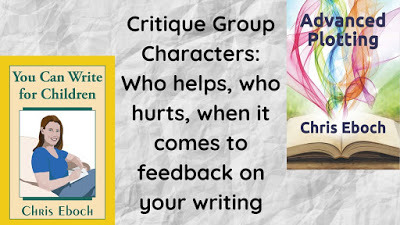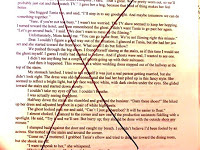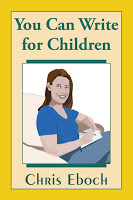Critique Group Characters: #amwriting tips for better feedback on your #writing
 This excerpt from How to Write Great Stories, Articles, and Books for Kids and Teenagers is from the chapter on Critiques. See the list of topics to the right to find more on critiques.
This excerpt from How to Write Great Stories, Articles, and Books for Kids and Teenagers is from the chapter on Critiques. See the list of topics to the right to find more on critiques.Here are some specific character types to watch out for in your critique group.
Critique Group Characters
Watch out for the following personality types in a critique group:
 It's all wonderful!
It's all wonderful!Art by Lois BradleyThe Cheerleader. She loves everything you do! This is gratifying, especially when you are doubting your talent, but it’s not particularly helpful in improving your work.
The Grammarian. He doesn’t have a lot to say about the content of your work, but he’ll circle every typo in red pen and may insist you follow strict grammar rules that have gone out of date. (By the way, I never use red pen on critiques – blue, purple, or green ink stands out from the black text, without that negative association of graded English papers.)
 Me? An opinion?The Mouse. You can’t tell whether or not she likes your work, because she never voices an opinion. She might hide behind the excuse that she’s not experienced enough to offer feedback. She’ll do this for years.
Me? An opinion?The Mouse. You can’t tell whether or not she likes your work, because she never voices an opinion. She might hide behind the excuse that she’s not experienced enough to offer feedback. She’ll do this for years.The Perpetual Beginner. He truly isn’t experienced enough to offer feedback, and he never seems to improve. This type can be divided into The Rut, who brings in the same manuscript over and over without ever making substantial changes (despite all your thoughtful advice) and The Hummingbird, who throws away a manuscript as soon as it’s gotten one negative comment, preferring to work on something new.
The Chatterbox. She wants to talk about anything and everything – other than the manuscripts you’re supposed to be critiquing. This person sees a writing group as a social occasion, not a way to improve your craft.
 That's not how I'd do it.Father Knows Best. He always has an opinion, which he voices clearly and often. He prefers to discuss how he would write the story if it were his own, ignoring the author’s vision.
That's not how I'd do it.Father Knows Best. He always has an opinion, which he voices clearly and often. He prefers to discuss how he would write the story if it were his own, ignoring the author’s vision. The Bully. She enjoys tearing apart your manuscript. No suggestions, just criticisms bordering on insults.
All these characters have one thing in common. They don’t help you improve your work. Having one Cheerleader in the group can be nice, as it means you’ll hear some praise. The Grammarian may be useful, although often those comments are unnecessary and time-consuming when you are still developing a story and focusing on the big picture, not proofreading.
The Mouse and the Perpetual Beginner don’t do a lot of harm, but they waste your time. Why should you spend hours doing thoughtful critiques when you’re not getting anything in return? (Note, sometimes these people can learn over time. Ask for the type of feedback you want, such as "Please point out where you got bored or confused," or encourage them to use a critique form that asks specific questions. But if they won’t make an effort to be better critique partners, it may be time to end the relationship.)
 Some people hate everythingThe Chatterbox is an even bigger time waster. Sometimes that person can be controlled by having a set time for visiting, perhaps the first or last half hour of each meeting. Including some social time is a way for the group to bond. Some critique groups like to start or end with a nice potluck meal. You could also have one or two meetings a year that are purely social. If there’s a way to get Father Knows Best or the Bully to change their behavior, I don’t know it. They should be avoided.
Some people hate everythingThe Chatterbox is an even bigger time waster. Sometimes that person can be controlled by having a set time for visiting, perhaps the first or last half hour of each meeting. Including some social time is a way for the group to bond. Some critique groups like to start or end with a nice potluck meal. You could also have one or two meetings a year that are purely social. If there’s a way to get Father Knows Best or the Bully to change their behavior, I don’t know it. They should be avoided.A good critique is kind and supportive, pointing out both good qualities and weak spots in your manuscript, and giving you ideas for how to improve it. The best critiques leave you fired up and ready to get to work on revisions, even if you know you have a lot of work ahead. Look for people who can provide that.
If you've run into these characters, do you have advice on dealing with them? Are there other character types to watch out for?
 You can get this whole essay, and a lot more – including a chapter on Advanced Critique Questions – inYou Can Write for Children: A Guide to Writing Great Stories, Articles, and Books for Kids and Teenagers. Order for Kindle, in paperback, or in Large Print paperback.
You can get this whole essay, and a lot more – including a chapter on Advanced Critique Questions – inYou Can Write for Children: A Guide to Writing Great Stories, Articles, and Books for Kids and Teenagers. Order for Kindle, in paperback, or in Large Print paperback.Cat emoticons by Lois Bradley.
Chris Eboch is the author of over 60 books for children, including nonfiction and fiction, early reader through teen. Her novels for ages nine and up include The Eyes of Pharaoh, a mystery in ancient Egypt; The Well of Sacrifice, a Mayan adventure used in many schools; The Genie’s Gift, a middle eastern fantasy; and the Haunted series, about kids who travel with a ghost hunter TV show, which starts with The Ghost on the Stairs. Learn more at chriseboch.com or her Amazon page.
Published on April 11, 2021 09:00
No comments have been added yet.



